Acropolis: Tickets and Tours
Book your Acropolis tickets and tours to discover one of Ancient Greece’s most important surviving monuments. See the famous Parthenon and the Theater of Dionysus perched above the timeless city of Athens on this historic hilltop site.
Explore the Acropolis Museum to learn about the ancient Greek civilization and see fantastic views of the city from the top of Acropolis Hill.
Book your Acropolis tickets and tours to discover one of Ancient Greece’s most important surviving monuments. See the famous Parthenon and the Theater of Dionysus perched above the timeless city of Athens on this historic hilltop site.
Explore the Acropolis Museum to learn about the ancient Greek civilization and see fantastic views of the city from the top of Acropolis Hill.

(0/24) checking Musement...
Book your Acropolis tickets and tours to discover one of Ancient Greece’s most important surviving monuments. See the famous Parthenon and the Theater of Dionysus perched above the timeless city of Athens on this historic hilltop site.
Explore the Acropolis Museum to learn about the ancient Greek civilization and see fantastic views of the city from the top of Acropolis Hill.

Here's everything you need to know about the Acropolis, one of the most magnificent attractions in Athens.
How much do Acropolis tickets cost?

Acropolis tickets can be bought individually or bundled with entry to other attractions, such as the Acropolis Museum and the Temple of Zeus. You can also choose a self-guided or guided Acropolis tour that has Acropolis tickets included.
Standard Acropolis Tickets
Acropolis tickets can be purchased in person at the ticket office on the day of your visit.
- Standard Acropolis ticket (April to October): €20
- Standard Acropolis ticket (November to March): €10
- EU senior citizens (over 65) and non-EU citizens under 26 (year-round): €10
- All children under 6, EU citizens/residents under 26, and EU students have free admission.
Skip-the-Line Acropolis Tickets
Buy a skip-the-line Acropolis ticket online in advance to avoid waiting in line at the ticket office on the day of your visit.
- Skip-the-Line Acropolis ticket (with audioguide): €22
- EU senior citizens (over 65) and non-EU citizens under 26 have reduced entry of €10, which can only be purchased in person at the ticket office.
- All children under 6, EU citizens/residents under 26, and EU students have free admission, which can only be obtained in person at the ticket office.
Acropolis Combo Tickets
If you want to save time and money, you can buy a combo ticket for entry to the Acropolis and other nearby historical sites.
- Acropolis Combo Ticket: €30
These are also skip-the-line tickets, so you won’t have to wait in line when you get to the Acropolis. They are valid for 5 days, so you have plenty of time to thoroughly explore all the sites and museums. Be sure to check out Kerameikos, Hadrian's Library, Lykeion, Olympieio and the Ancient and Roman Agoras!
Please note that combo tickets are no longer available at discounted prices. For discounted tickets, you can only purchase single-entry tickets in person at the ticket counter at the entrance of each venue.
Who is eligible for discounts?
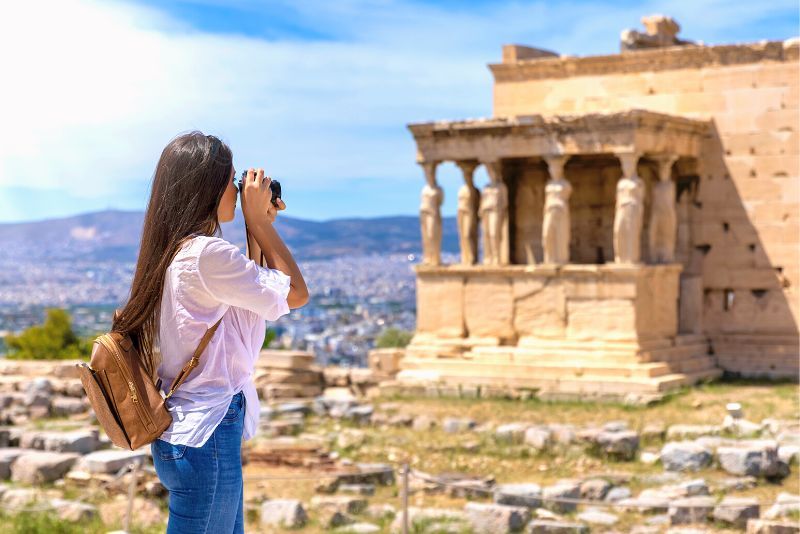
From April to October, EU senior citizens and non-EU citizens/residents under 26 are eligible for a 50% discount on a standard Acropolis ticket when they show a valid passport or ID.
From November to March, standard Acropolis tickets are at a 50% discounted price for everyone at only €10.
All children under 6, EU citizens/residents under 26 and EU students have free admission to the Acropolis year-round.
Is it possible to visit for free?
Yes! The Acropolis is free for everyone to visit on Sundays from November to March. You can also enjoy free admission on the following national and international holidays.
- March 6 (Melina Merkouri Day)
- April 18 (International Monuments Day)
- May 18 (International Museums Day)
- The last weekend of September (European Heritage Days)
- October 28 (Ohi Day)
All children under 6, EU citizens/residents under 26 and EU students 26 and older have free admission to the Acropolis year-round.
Should you book in advance?
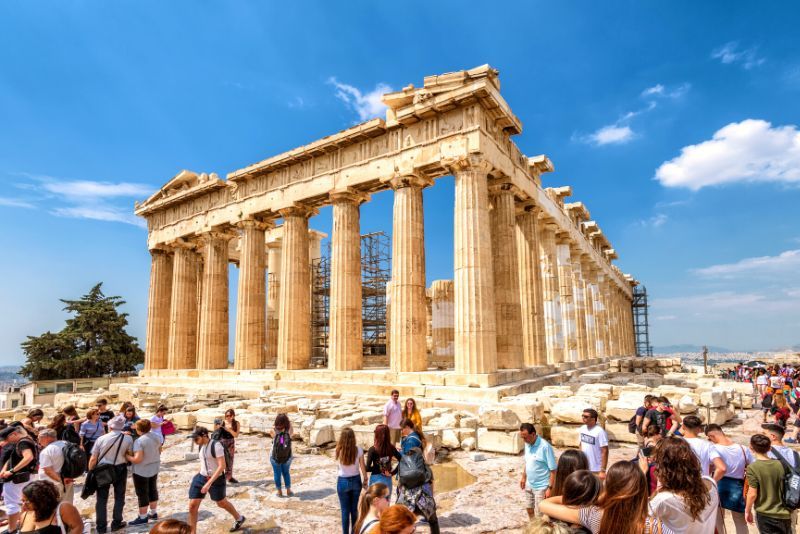
Yes, that’s a good idea. Pre-booking your ticket ensures that you are able to visit on the day you want. This will also save you time, as you won’t have to wait at the ticket office upon arrival.
Bear in mind that free and discounted tickets cannot be booked in advance. If you want to skip the lines, you will need to purchase standard tickets, even for those who qualify for a free or discounted ticket.
Another option is to book an Acropolis tour that already includes skip-the-line tickets.
What are the best Acropolis tours?

You can select from a wide range of group and private tours. There are plenty to choose from, and it can be overwhelming to search through all the options.
Fortunately, you have the best types of tours explained below to help you pick the Acropolis tour that’s right for you. Whether you prefer to explore by day or night, with a big group or small, this short guide will make it easier for you to make the best of your Acropolis excursion.
Guided tours
Climb your way through the ruins with an expert archaeologist, who will provide historical context and engaging anecdotes to reveal the secrets hidden in the dust-covered marble pillars towering all around you.
Only some Acropolis guided tours include the ticket in the price, so be sure to check if you need to pre-book your tickets. Generally, you can choose to do a 2-hour tour of the Acropolis archeological site or a 4-hour tour that includes both the site and the Acropolis Museum.
Private tours
If you’re looking for a more personalized experience, then a private Acropolis tour with your very own guide is just the thing. The tour can focus on what you’re most interested in, from the history, architecture and mythology to the archeological techniques to extract and preserve the artifacts found on the sites.
Private tours can be combined not only with visits to other sites but also with other experiences, such as food tours, cooking classes and wine tours and tastings. You can also choose from tours lasting only a few hours or half-day and full-day tours with pickup directly from your hotel or cruise ship.
Audioguide tours
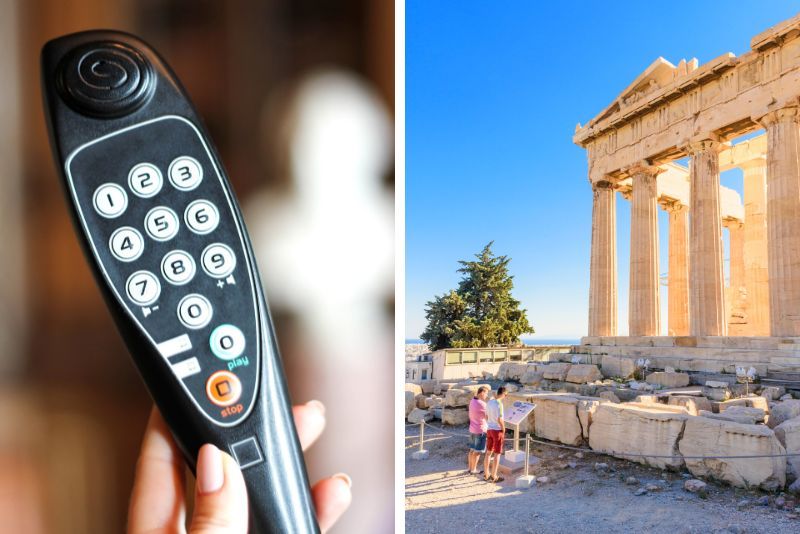
If you prefer to wander on your own around the ruins, but still appreciate the historical context of a guided tour, then an audioguide tour is just what you need. Explore the Acropolis and other historical sites with an audioguide in English, Spanish, French, German, Italian or Greek.
Many of the audioguide tours include an Acropolis standard or combo ticket at a reduced price, so buying the audioguide and ticket together is often much cheaper than buying your ticket on-site. Don’t overlook this bargain!
At night tours
Unfortunately, the Acropolis is closed at night. The closing time of the Acropolis is directly related to the sunset, but if you want to get as close as possible, you can check our page about night tours at the Acropolis for suggestions!
The Acropolis museum is open on the weekend until 8 PM and Fridays until 10 PM from April to October.
Morning or afternoon tours
Avoid the crowds at midday and enjoy a more leisurely tour experience. Early birds can take a guided morning tour of the Acropolis and beat the heat. You can also visit in the late afternoon for a memorable sunset overlooking the city of Athens.
Family-friendly tours
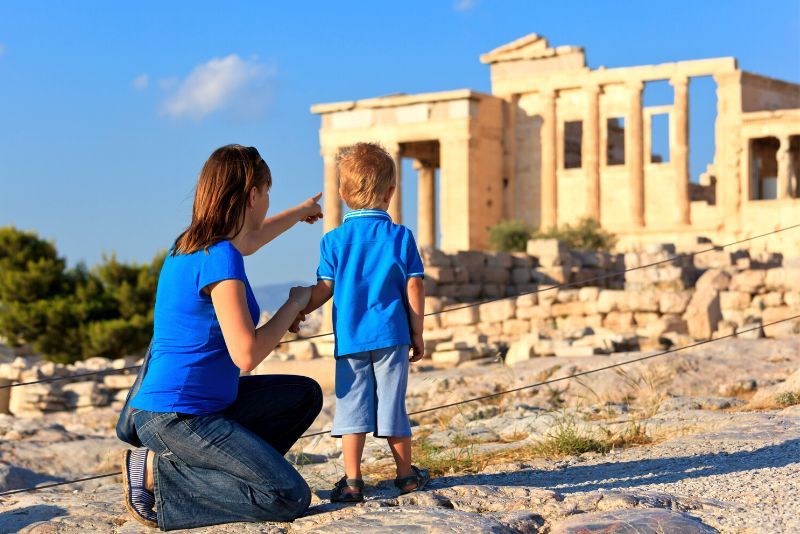
If you’re hoping to keep your kids entertained while they learn a bit about the history of this ancient city, then you can book a family-friendly tour.
Specially-trained guides will uncover the myths and legends hidden in the stones of the Acropolis through stories that are engaging for children of all ages (and the curious child inside each one of us).
A bonus of family-friendly tours is that after your visit, you will receive a booklet detailing what you’ve seen with activities to keep your child engaged in the tales of Ancient Athens.
Scavenger game tours
Scavenger games provide another fun option to keep your kids engaged on those long days exploring Athens. Choose from self-guided, group and private tours that feature treasure hunts to lead you around the city.
Each scavenger game has a different theme, from food to mythology to the mysteries of lost archeologists and falsely imprisoned Athenians. One of the fun games you can play is the mission to save the Magas the Greek, where you follow clues hidden in ancient and contemporary sites while sampling plenty of Greek cuisine on the way. Kalí óreksi!
Segway tours
If you’ve already spent enough time on your feet roaming around the ancient ruins, then you might want to consider choosing from one of the Segway tours in Athens.
These tours are typically private or in small groups. There are also at-night Segway tours to enjoy the cool evening breeze while zipping from ancient site to ancient site.
Are there any combined tickets or tours for the Acropolis and other attractions?

See a handful of Athens's best attractions in a single day by combining your Acropolis tour with a trip to other top locations. This is a great way to save time and money on ticket and tour prices.
- Acropolis and Acropolis Museum: Visit the famous Acropolis and the Acropolis Museum to see the most important artifacts from the historic site.
- Acropolis, Acropolis Museum and City Walking Tour: Take a guided tour of the Acropolis and the Acropolis Museum before heading out for a walking tour in Athens.
- Hop-on hop-off bus tour to Acropolis and Acropolis Museum: Enjoy a hop-on hop-off bus tour in Athens and visit the Acropolis Museum and/or the Acropolis on the same day.
What will you see inside?
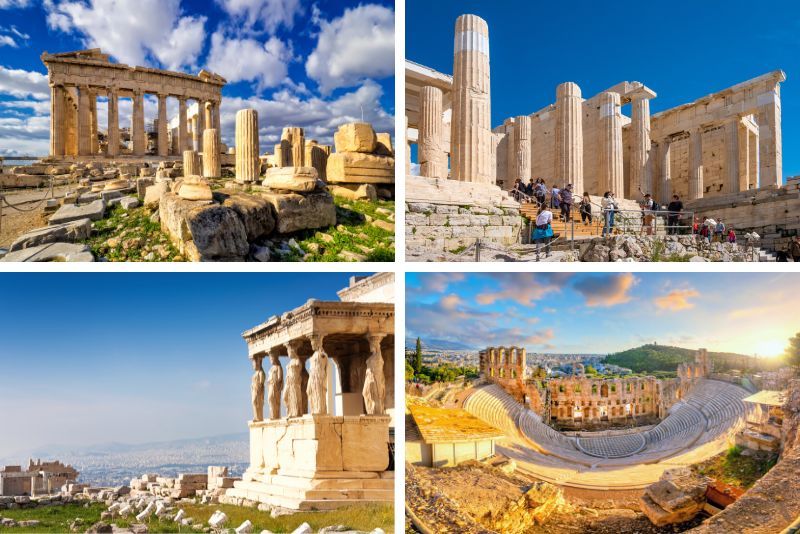
The Acropolis is a hilltop complex in Athens littered with ancient temples, sanctuaries and amphitheaters — all constructed between 2,000 and 2,500 years ago.
The term “acropolis” translates literally to “high city,” and there were many more examples scattered throughout ancient Greece, but the Acropolis in Athens is the most impressive and well-known of all — still standing today as a symbol of the birthplace of Western civilization.
Inside the Acropolis
The Parthenon is what everybody sees when they look up at the Acropolis, but there are over 20 other structures to appreciate and explore — each with its own histories to uncover. Here’s a little preview of the most impressive ones.
- The Parthenon
- The Propylaea
- The Temple of Athena Nike
- The Erechtheion
- The Herodeion
- The Theater of Dionysus
The Parthenon
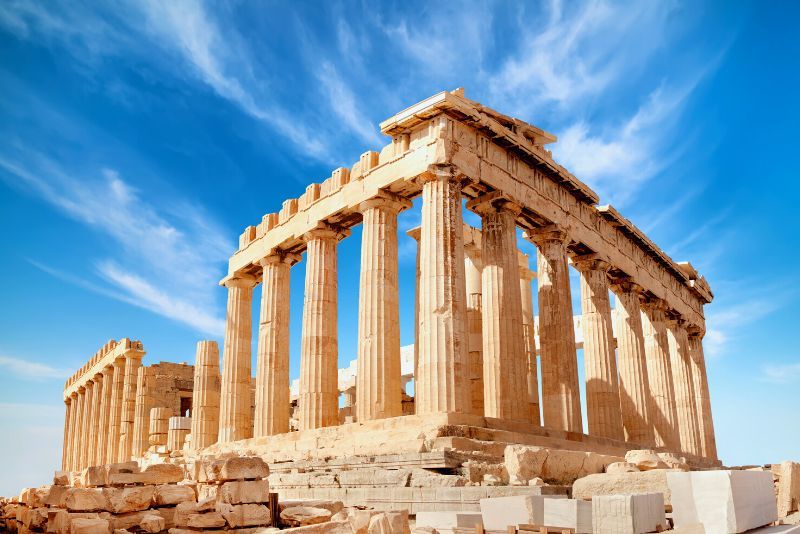
Besides being the most famous structure in the Acropolis, it is also one of the oldest, dating back to around 450 BC. The Parthenon was one of the largest temples in ancient Greece and was built to display the Athenians' wealth, as well as their technical and cultural prowess.
The Parthenon is known as the eighth wonder of the classical world and the birthplace of democracy. If the facade looks familiar, that’s no surprise. The Austrian Parliament building, La Madeleine in France and the White House in the USA all acknowledge this cultural heritage with their similar Neoclassical designs.
When you look at the Parthenon from a distance, the perfect lines you see are actually an intentional optical illusion. When you’re finally up close, see if you can perceive how there are virtually no straight lines or right angles in the Parthenon — even the columns are not straight along the vertical axis, but rather bulge in the middle (which you will likely find relatable after indulging in feasts of Greek cuisine!).
The Propylaea
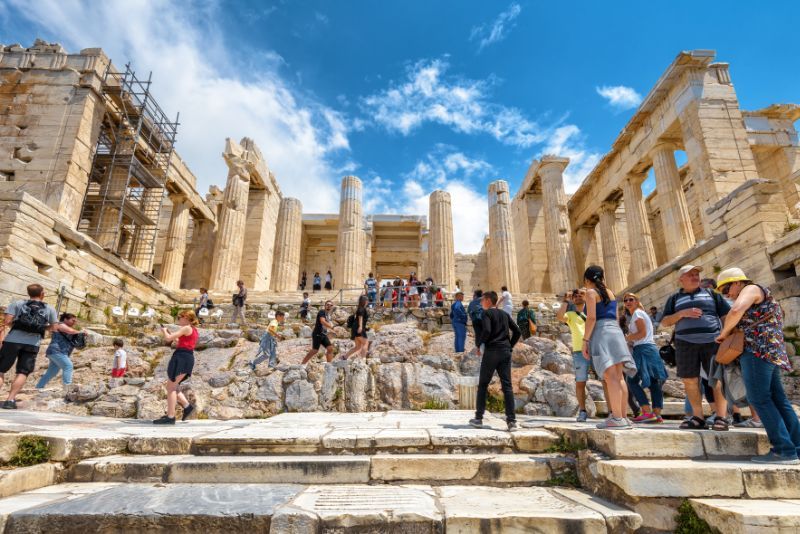
The Propylaea, an ancient Greek term for the entryway to a temple, is the first sight to greet you at the main entrance on the western slope of the Acropolis. Make sure your shoes are tied because there will be quite a few stairs to climb.
If you look up, you will see a unique architectural feature. The horizontal marble beams of the original Propylaea were so long that they had to be supported by iron bars. This is uncommon in ancient Greek architecture and has only been discovered at one other site — the Temple of Zeus at Agrigento.
After climbing up this monumental staircase, you will come across the most important temple in the Acropolis, which is dedicated to the goddess responsible for protecting the citizens of Athens — Athena.
The Temple of Athena Nike
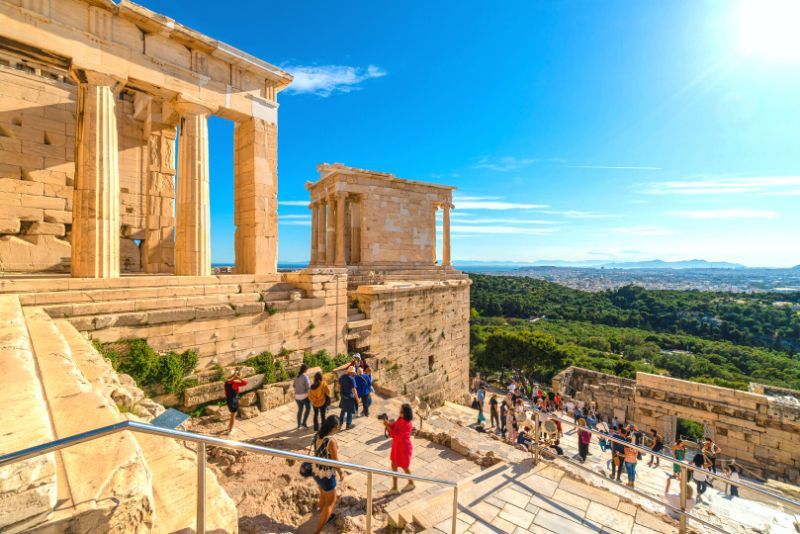
This towering structure of marble and limestone dates back to 420 BC and served as a place of worship for the sister goddesses — Athena and Nike. The patron deity of Athens and the goddess of victory were so often portrayed together that the two were eventually synchronized as Athena Nike, or Athena of Victory.
You can find the original marble statues that once adorned this temple housed in the Acropolis Museum. One notable example is Nike Adjusting Her Sandal, which employs the wet drapery sculpting technique to balance modesty with celebration of the human form.
Even without these statues, the temple itself cuts an imposing figure despite being smaller than some of the others on the hill. You can appreciate the golden-white marble carved from Mount Pentelicus to construct the edifice and its eight Ionic columns that provide support from two sides.
The Erechtheion
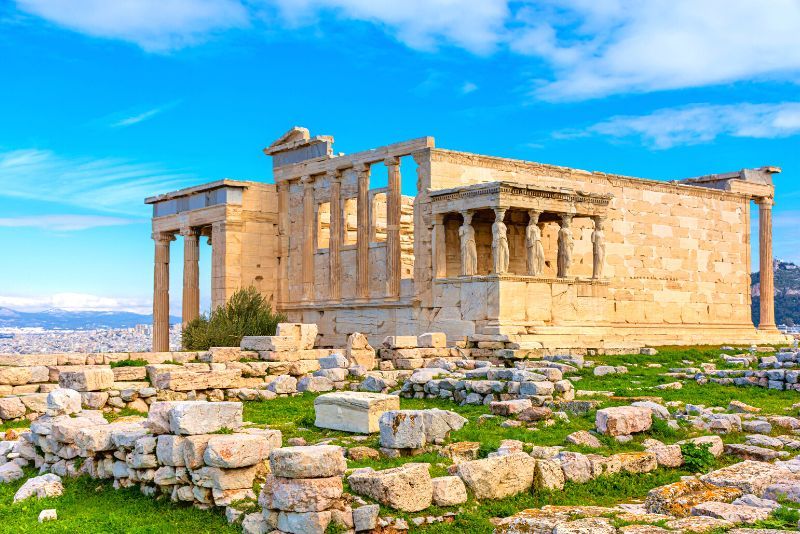
You will find the Erechtheion on the north slope of the Acropolis. Named after the mythical king of Athens, Erectheus, this sacred temple was completed around 400 BC and is most appreciated for the six female figures carved in stone, which serve as support columns for the structure.
These Caryatids, or maidens of Karyai, are masterpieces of Ancient Greek architecture. Even with the weight of the world on their heads, the stone ladies are still standing after all these years.
However, the originals were moved to the museum a few decades ago to protect them from the elements. What you see on-site are actually replicas of the originals. When you’ve had enough of that blistering Greek sun, why not pop into the museum and say hello to the original lovely ladies of Karyai?
The Herodeion
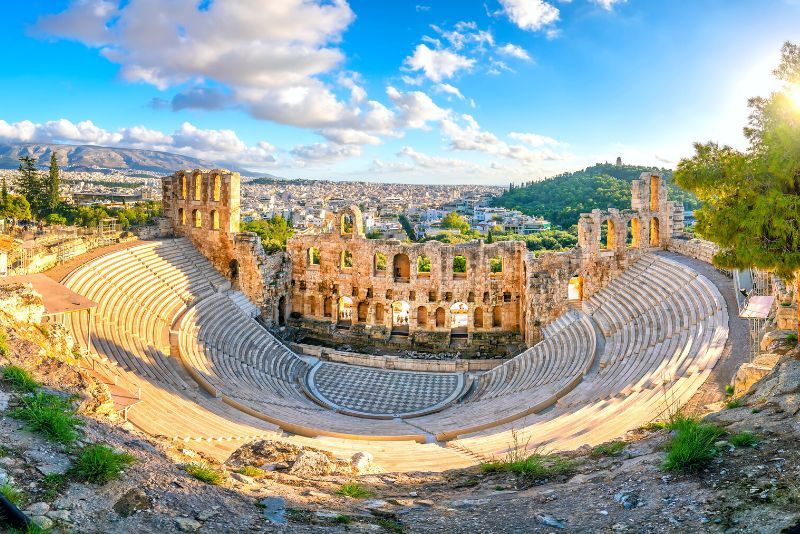
You will find the Herodeion on the southwest slope of the Acropolis. Also called the Odeon of Herodes Atticus, this theater is different from the other structures in the Acropolis for two reasons.
One is that it’s relatively modern. Herodes Atticus, Roman senator and Athenian rhetorician, funded the building of the theater in 161 AD in honor of his wife, Appia Annia Regilla, who was tragically murdered while eight months pregnant.
Before you sigh at such a sad and touching tribute, you must delve deeper into the story. Many suspected that Atticus was the one behind the murder! What a real-life Greek tragedy to reflect on as you wander around these ruins.
The second differentiating feature is that the venue still hosts concerts and performances, mostly from May to October, as part of the annual Athens Festival. This is one of the biggest events in Greece and has seen performances from the best philharmonic orchestras and appearances from musical legends, such as Leonard Bernstein and Luciano Pavarotti.
The Theater of Dionysus
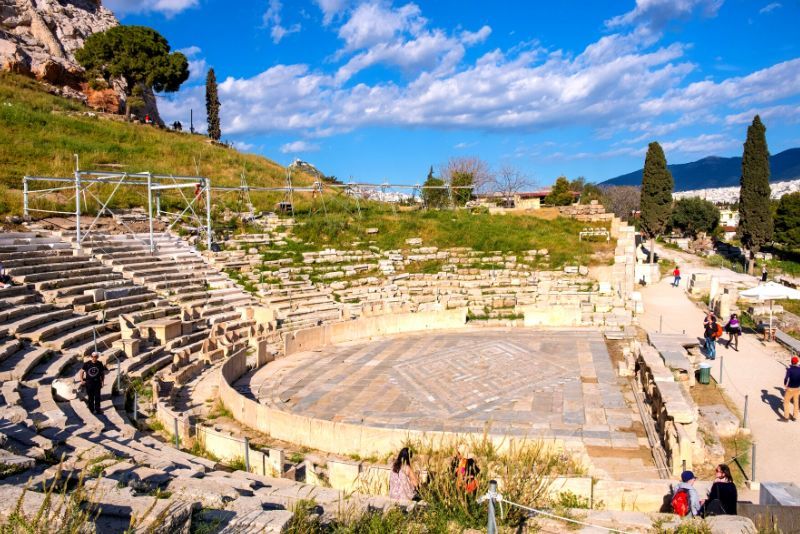
The Theater of Dionysus is believed to be the first venue for theatrical performances in the world. You will find it on the southeastern slope near the side entrance of the Acropolis.
Although dating back to the 4th and 5th century BC, the theater was in constant use up until the fall of the Roman Empire. After that, it was abandoned and allowed to decay. It wasn’t until the 19th century that it was finally excavated and restored once again.
If the Acropolis stands as a symbol of the birthplace of Western civilization, then the Theater of Dionysus would be the birthplace of Western comedy and drama. Later, when you’re back home and crunching popcorn at the movies, you can remember the time you set foot on the world’s very first stage — the starting point for all the plays and films yet to be performed.
Outside the Acropolis
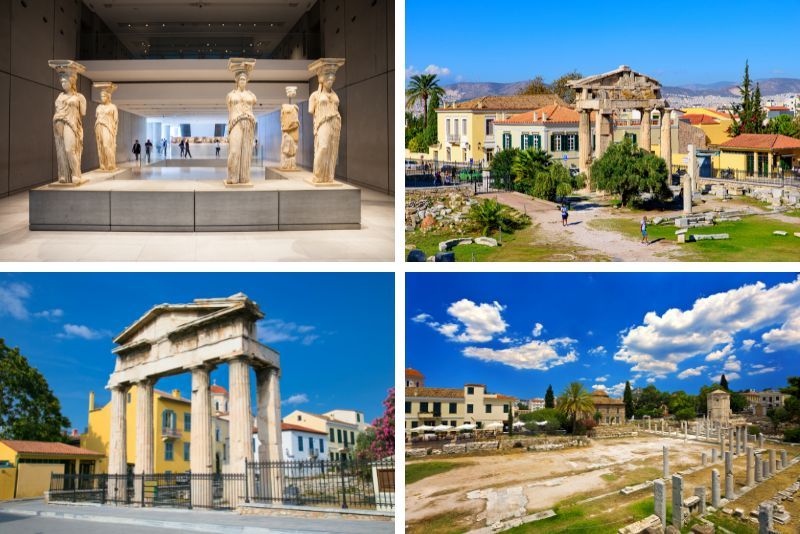
Near the grounds of the Acropolis, you have several other historical sites to check out. They are all included with the combo ticket, except for the Acropolis Museum, so don’t forget to book a separate ticket to the museum.
- The Acropolis Museum
- Kerameikos
- The Ancient Agora
- The Roman Agora
- Hadrian's Library
The Acropolis Museum
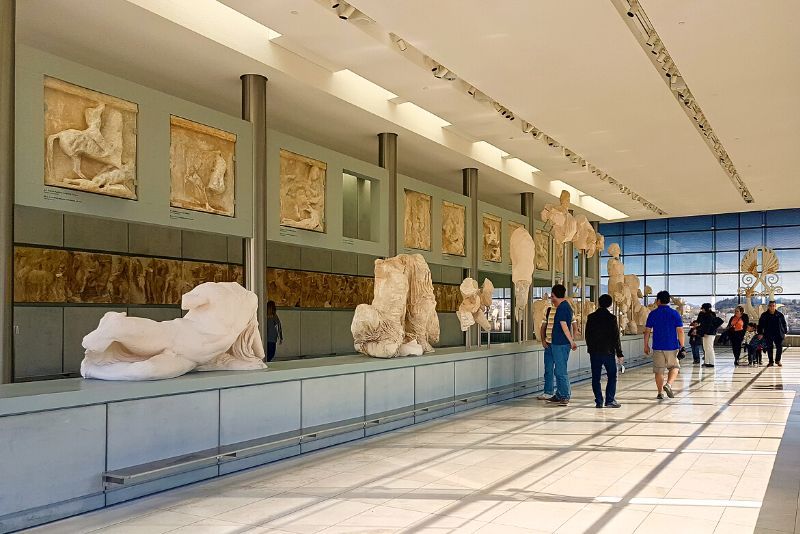
Considered one of the best museums in the world, this is a must-see to complement your visit to the Acropolis archeological site. This state-of-the-art museum houses and preserves the original historical artifacts that have been discovered at the Acropolis.
Many of the statues and monuments that you see outdoors are actually replicas and not the ones that the ancient Greeks shaped and carved with their own hands. Not to say that the replicas aren’t stunning recreations, but there’s something special about knowing that the object you’re observing was once labored over in the times before Christ.
The archeological site and the museum of the Acropolis are actually two separate venues with different entrances. Each requires its own separate ticket for entry, which is not included in the combo ticket.
Acropolis Museum tickets cost €15 from April to October and €10 from November to March. Conditions for reduced and free tickets are the same as the Acropolis. Reduced tickets are €10 in the high season and €5 in the low season.
You can get to the museum by leaving through the side exit on the southeastern slope right next to the Theater of Dionysus. If you’re traveling by metro from somewhere else in Athens, it is only a minute’s walk from the stop Akropoli.
Kerameikos
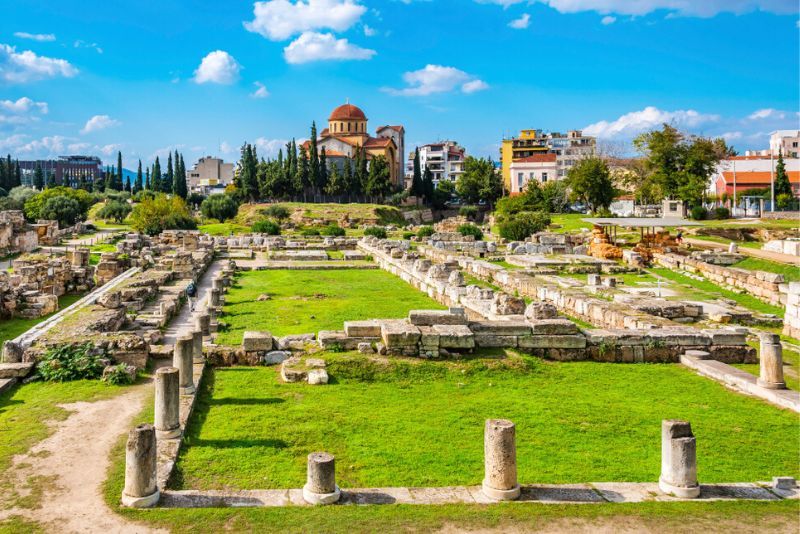
Derived from the Greek word for pottery, this settlement was where the best potters and vase painters of Ancient Athens practiced their craft. Curiously enough, the area was also a cemetery, with the earliest tombs dating back to 2000 BC!
All the most important Athenian vases came from Kerameikos. The most famous of these was the Dipylon Oinochoe — a priceless archeological find, as it bears the earliest inscription of the Greek alphabet dating back to 800 BC. You will find many vases similar to this one at the on-site museum.
You can easily walk from the Acropolis to Kerameikos. All you have to do is go northwest for 2 kilometers, which should take you about 20 minutes. If you make a slight detour and head due north, you can visit some other sites on the way, including the Ancient Agora, the Roman Agora and Hadrian’s Library.
The Ancient Agora
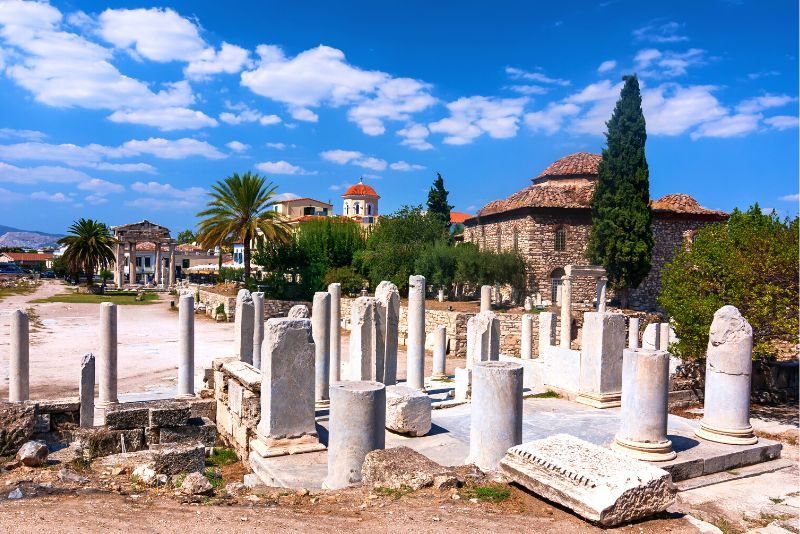
Agora means “gathering place” in ancient Greek. True to its name, this is where Athenians came to discuss and decide on political issues. Some of the very first acts of democracy were carried out right here.
You can see a poignant symbol of democracy in the on-site museum, which houses a carved marble relief depicting the people of Athens being crowned by Demokratia. It also bears an inscription against tyranny that was a precedential law passed by the people of Athens back in 336 BC.
The Ancient Agora is easy to get to from the Acropolis. All you have to do is walk about 10 minutes north. Be sure to stop by the Roman Agora on the way there.
The Roman Agora
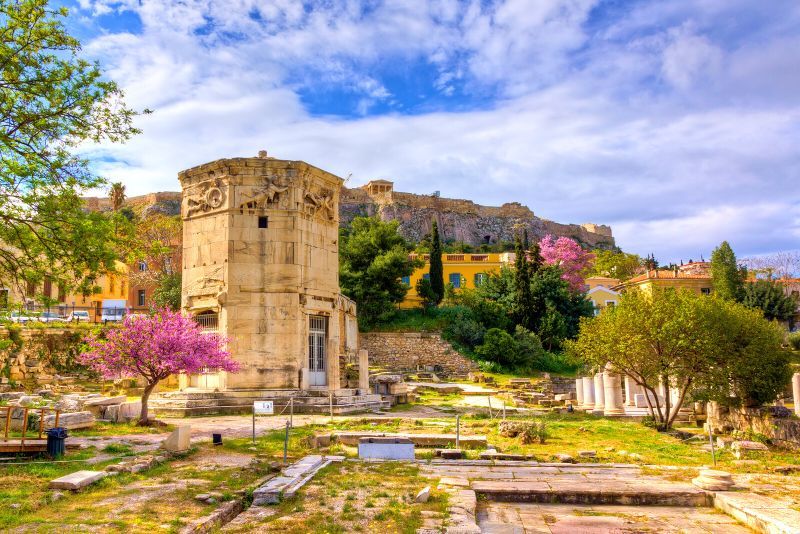
Built in the first century AD, the Roman Agora replaced the Ancient Agora of Athens as the main gathering place for inhabitants of the city. Here you will find a large courtyard surrounded by marble colonnades.
As you enter, if you look on top of the stone pillars that make up the Gate of Athena Archigetis, you will see an inscription crediting Julius Caesar and Augustus for providing funds for the construction of the agora. If want to test your Latin skills, try to decipher the message for yourself!
You can get to the Roman Agora from the Acropolis in less than 10 minutes by foot. Be sure to check out the Ancient Agora, which is only a few minutes further north.
Hadrian’s Library
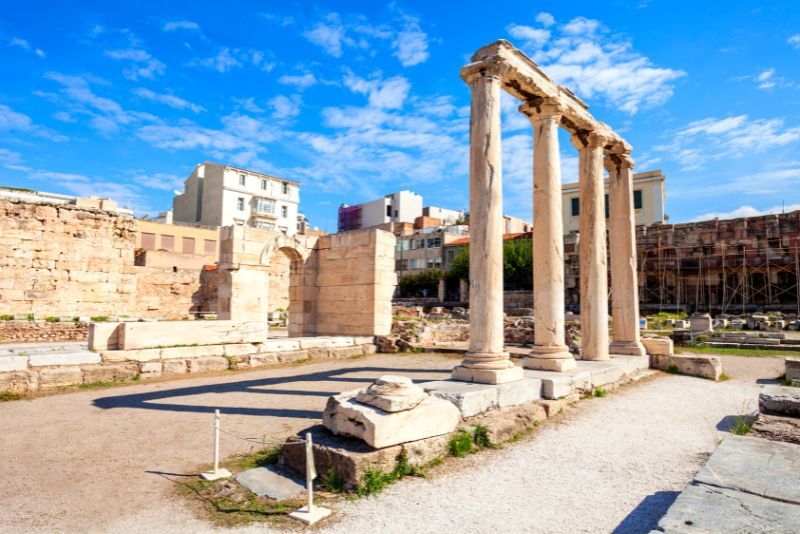
Built by the Roman Emperor Hadrian in 132 AD, this library complex once covered over 10,000 square meters on three floors. However, housing books was only one of its purposes. This reader’s paradise also featured porticoes, gardens and a pond for patrons to calmly contemplate life’s big questions away from the noise of the city.
Unfortunately, what remains today is only a small fraction of the nearly 100 marble columns that originally supported the immense structure. You can still see the entrance facade, which will give you an idea of the sheer scale of the original building.
You can get to Hadrian’s Library from the Acropolis in about 10 minutes on foot. Just head due north. Be sure to check out the Ancient Agora and the Roman Agora, which are both nearby.
How to get to the Acropolis?
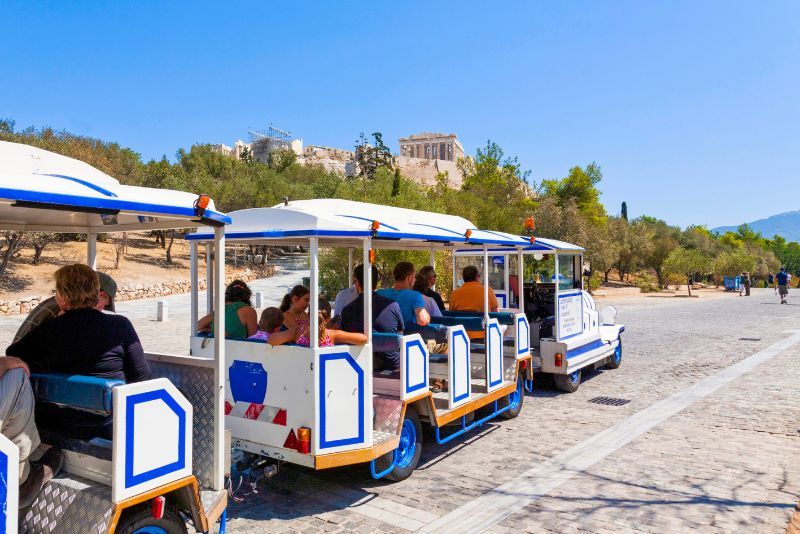
The Acropolis is in the historic center of Athens on top of a limestone hill. You can see it clearly from nearly anywhere in the city.
There is a main entrance on the western slope where you can buy your tickets and a side entrance on the southeastern slope reserved for skip-the-line ticket holders and small group tours.
By foot
From Monastiraki Square near Placa, you will only need to walk about 10 minutes to reach the main entrance of the Acropolis. This route passes by Hadrian’s Library, the Roman Agora and the Ancient Agora, so you can make stops at these sites on the way if you want.
By bike
If you’re cycling around Athens, the Acropolis museum has bike racks at the main entrance on the pedestrian street Dionysiou Areopagitou. There is also a bike rack at the entrance of the metro station Akropoli.
By metro
You have two options. Take metro line M1 or M3 to the stop Monastiraki for a 10-minute walk to the main entrance, or take metro line M2 to the stop Akropoli for a 2-minute walk to the side entrance.
From the Akropoli metro station, you will only need to walk about 2 minutes to reach the side entrance of the Acropolis. This entrance is only for pre-booked ticket holders and small group tours.
By tram
The nearest tram stop to the Acropolis is called Leoforos Vouliagmenis and is on the T6 line. This will leave you about a kilometer away from the main entrance of the Acropolis, but it’s only a 5-minute walk from the Acropolis museum.
By trolly
You can get there by taking trolly lines 1, 5 or 15. The nearest stop to the Acropolis is called Akropole, and the stop called Makrigianni will leave you right in front of the Acropolis Museum.
By bus
The city bus has the same two stops as the trolly, but there are over two dozen different bus routes you can take. Wherever you are in Athens, there’s a bus that can get you to the Acropolis.
You could also take a hop-on hop-off bus tour in Athens. The bus leaves regularly from Syntagma Square until 7 PM in the summer. There are also two other lines leaving every hour — the Beach line starting in Plaka and the Piraeus line starting at the Acropolis.
By car
If you travel by taxi to the Acropolis from Athens International Airport, you can reach the temple complex in 30 minutes to an hour. It isn’t too much more expensive than public transportation, so it’s an option worth considering.
If you plan to rent a car, be aware that free parking is difficult to find in the city center, especially near popular attractions. However, there are parking garages that cost around €25 per day.
By guided tour
This is certainly the most convenient way to get to the Acropolis. You can outsource all the stress and concerns about logistics to your tour guide, who will pick you up directly from your hotel or cruise ship.
What are the opening times?
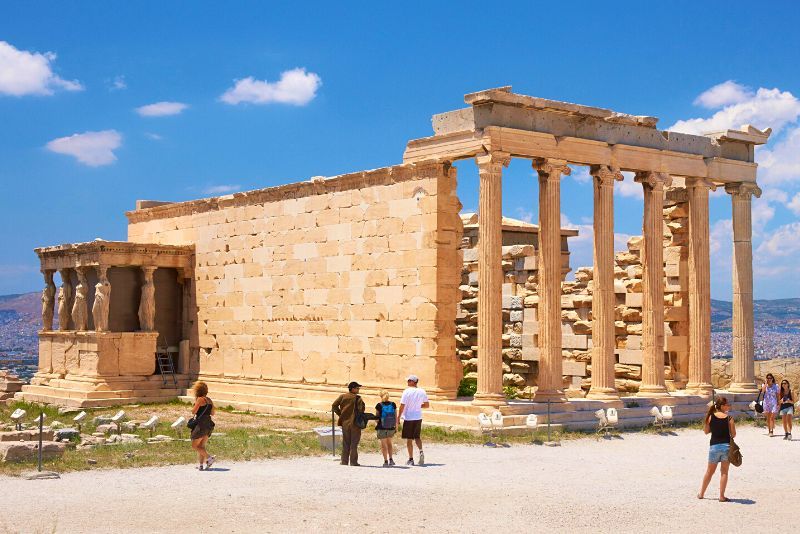
The Acropolis is open from 8 AM to 7:30 PM from April to mid-September and 8 AM to 5 PM from November to March.
From mid-September until the end of October, the closing time is reduced by 30 minutes every two weeks to account for the earlier sunset. In other words, the Acropolis closes at 7 PM in the second half of September, 6:30 PM in the first half of October and 6 PM in the second half of October.
The last entrance to the Acropolis is half an hour before closing time. However, the typical visit lasts around 2 hours, so it’s better to arrive earlier if you can.
When is the best time to visit the Acropolis?
The Acropolis is the most popular attraction in all of Athens, and it is very busy throughout the year. Try to visit in the early morning or late afternoon to avoid the largest crowds and the full heat of the sun.
Which other attractions can be visited in the city?
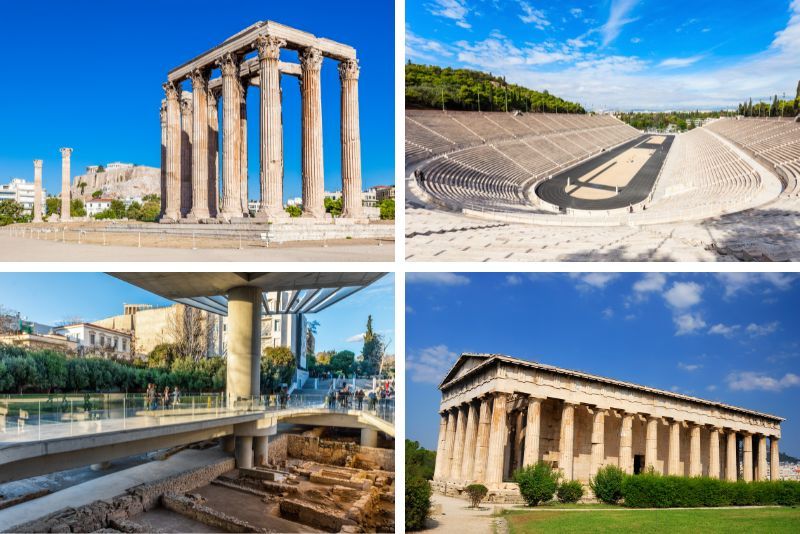
Travel tips
- Book your Acropolis tickets in advance to jump the lines at the ticket booth and get the best deals on combination tickets.
- Visit early or late in the day to avoid the midday crowds.
- There is very little shade at the Acropolis, so remember to wear sunscreen and a hat, and to drink plenty of water.
- Wear comfortable shoes, as there will be some walking required on rocky and uneven ground.
- If you don’t plan to take a guided tour, read up on the history of the Acropolis before you go to make your visit more enjoyable.

